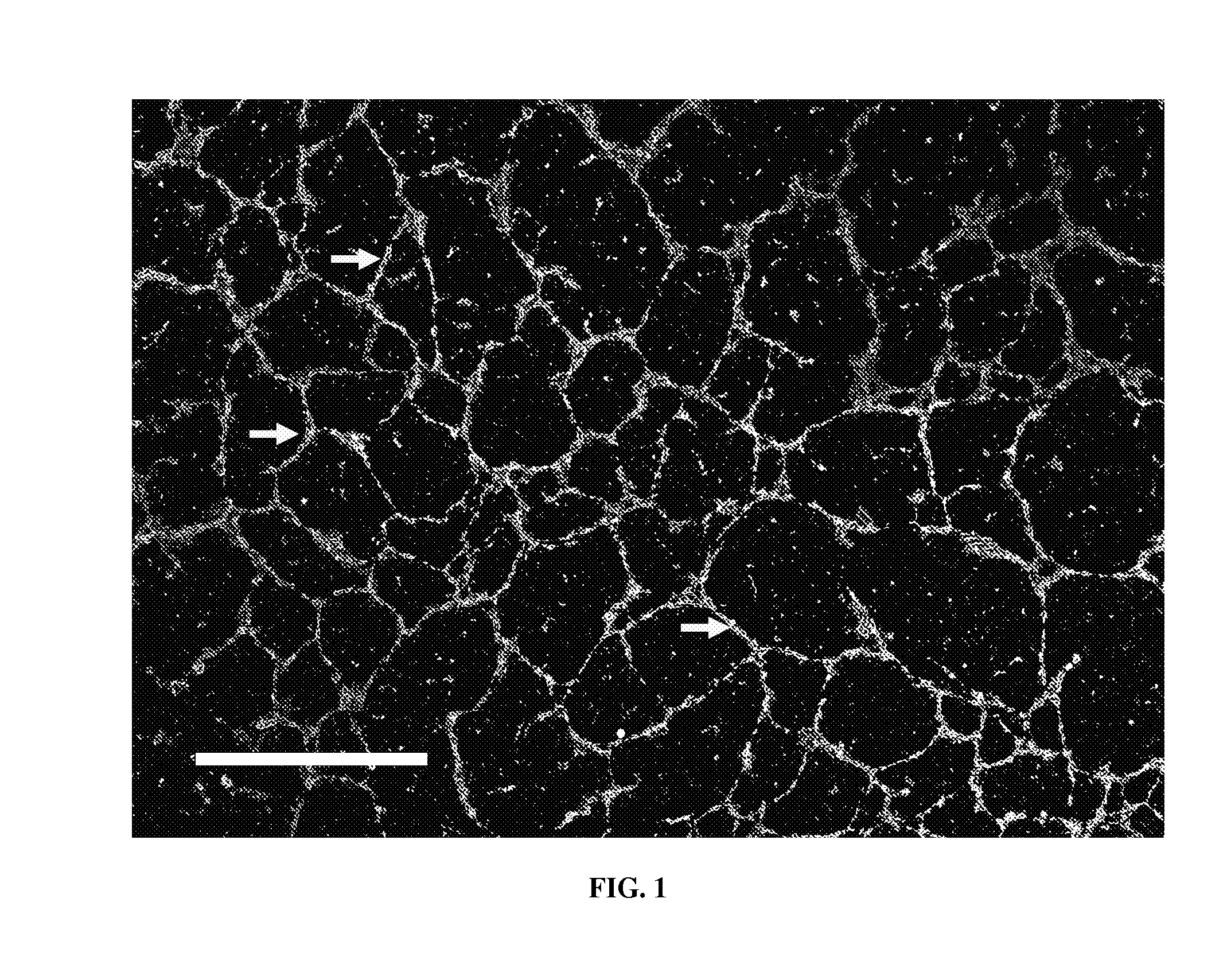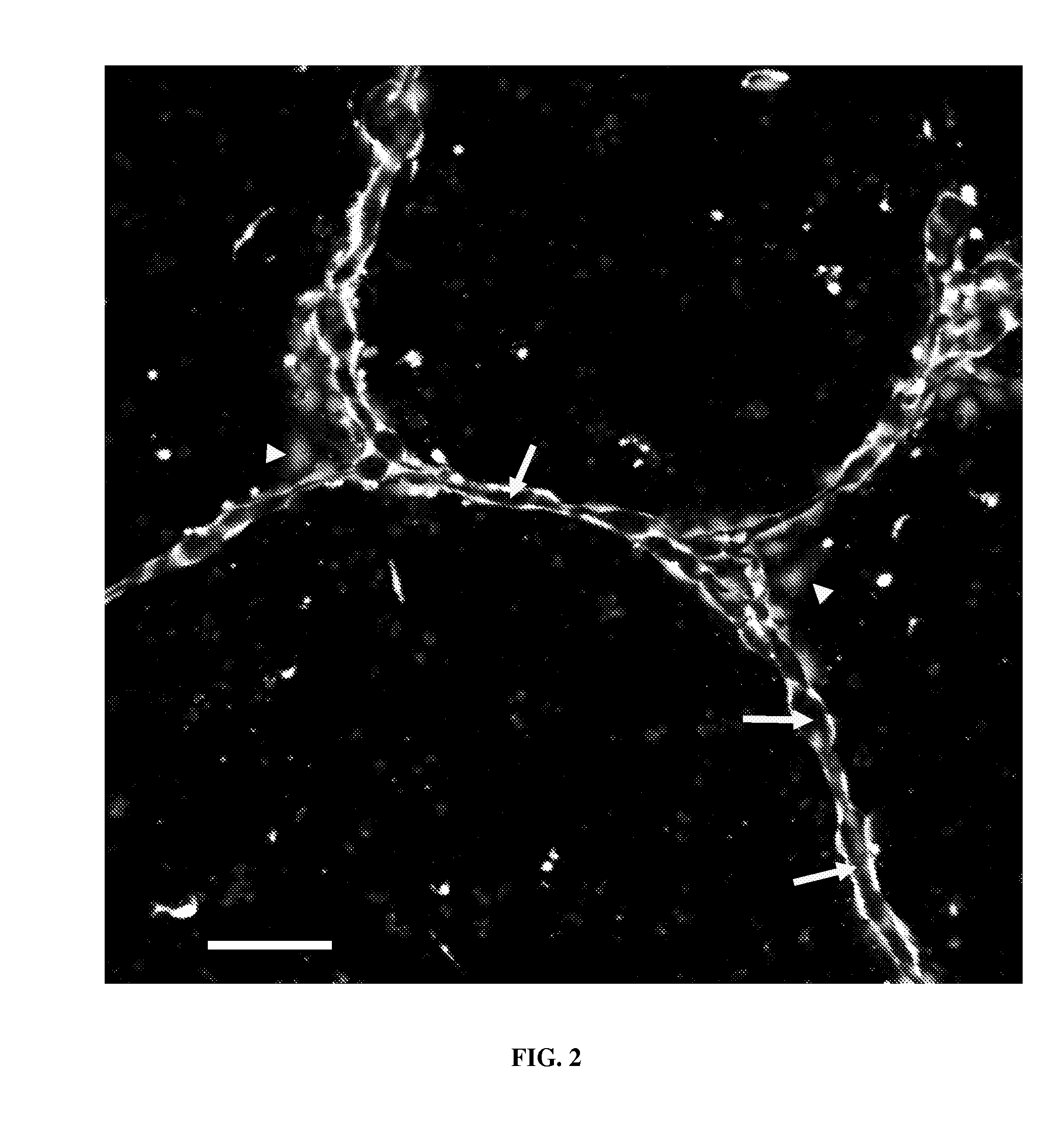Engineered lumenized vascular networks and support matrix
a technology of lumenized capillaries and support matrix, which is applied in the field of biomedical tissue engineering, can solve the problems of inability to rapidly create lumenized capillary networks with properties, current methods of tissue engineering are limited to relatively thin and/or avascular, and vascularization remains a critical obstacle for engineering thicker, metabolically demanding organs, etc., to achieve the effect of reducing the chance of rejection, and increasing the proliferation of seeded end
- Summary
- Abstract
- Description
- Claims
- Application Information
AI Technical Summary
Benefits of technology
Problems solved by technology
Method used
Image
Examples
example 1
Sample Capillary Fabrication Devices Using Matrigel™ in the Support-Generating Medium to Culture HUVECs or ECFCs
[0124]Materials.
[0125]Matrigel™ is purchased from BD Biosciences. Single-donor human umbilical cord endothelial cells (HUVECs) are cultured according to protocols provided by PromoCell™. It is recommended to use HUVECs passaged less than 4 times. Alternatively, endothelial colony forming cells (ECFCs) are used. ECFCs may be extracted from human peripheral and umbilical cord blood.
[0126]A stock of 1× Matrigel™ is diluted about 30 to about 60 times with about 4° C. cell-culture medium (from PromoCell) to produce a homogeneous support-generating medium. The support-generating medium is plated in non-treated polystyrene petri dishes as the cell-culture surface which has a hydrophobic surface. Components of the mixture settle / stick to the bottom of the dish and form a loosely connected low density environment. About 3 ml of the support-generating medium is enough for 35 mm dish...
example 2
Sample Custom-Patterned / Controlled-Geometry Capillary Fabrication Devices
[0134]In this example, the cell-culture surface in the capillary fabrication device has hydrophobicity gradients. For example, the non-treated polystyrene petri dish in Example 1 can be replaced with a patterned ultra low adhesive polystyrene dish before plating support-generating medium. The ultra low adhesive polystyrene dish provides a cell-culture surface which is more hydrophilic than regular non-treated polystyrene petri dishes. The pattern on the ultra low adhesive polystyrene dish comprises a hexagonal network of narrow bands of 5 to 15 microns in width and 200 to 250 microns in length of less hydrophilic cell-culture surface. Cells of endothelial lineage can be used. The custom-patterned / controlled-geometry capillaries form on top of the predefined hexagonal network pattern of less hydrophilic cell-culture surface.
[0135]Optionally, the non-treated polystyrene cell-culture surface in Example 1 can be pr...
example 3
Sample Capillary Assay Devices
[0138]Capillary networks are grown as described in Example 1 using the capillary fabrication device or Example 2 using the custom-patterned capillary fabrication device combined with one or modifications with the aim of determining the effect of those modifications on the cultured cells or on the resulting capillary networks.
[0139]The capillary assay device can be used for determining the proangiogenic effects of different isoforms of vascular endothelial growth factor (VEGF) including soluble and ECM-bound isoforms. The cells in the capillary assay device are cultured inside the support medium, thus the device provides quasi-in vivo conditions for the interaction of VEGF isoforms and the cells. Cells in the 2-dimensional standard Matrigel™ capillary fabrication device are cultured on top of a thick solidified gel which differs significantly from in vivo conditions.
[0140]The capillary assay device also can be used for determining the effects of various ...
PUM
| Property | Measurement | Unit |
|---|---|---|
| thickness | aaaaa | aaaaa |
| diameter | aaaaa | aaaaa |
| diameter | aaaaa | aaaaa |
Abstract
Description
Claims
Application Information
 Login to View More
Login to View More - R&D
- Intellectual Property
- Life Sciences
- Materials
- Tech Scout
- Unparalleled Data Quality
- Higher Quality Content
- 60% Fewer Hallucinations
Browse by: Latest US Patents, China's latest patents, Technical Efficacy Thesaurus, Application Domain, Technology Topic, Popular Technical Reports.
© 2025 PatSnap. All rights reserved.Legal|Privacy policy|Modern Slavery Act Transparency Statement|Sitemap|About US| Contact US: help@patsnap.com



